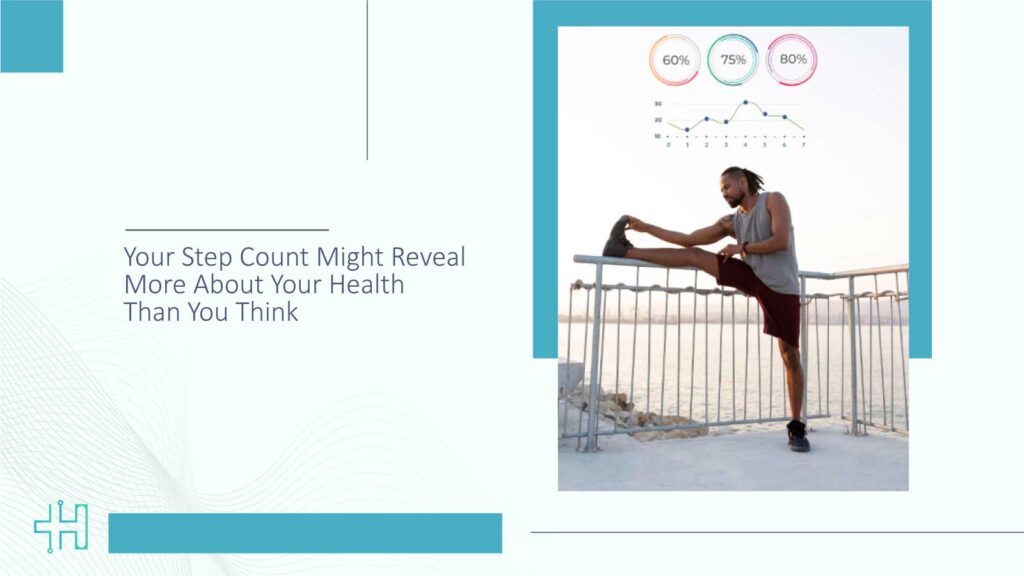Have you ever considered that the total number of steps you take in a day could give you insights about your health? That number we all glance at on our smartwatch may have some great health insights. Step count is more than just fitness tracking now; they are providing details about cardiovascular health, metabolic health, and even mental health.
This article explains how health technology is transforming the simple step into a powerful metric for someone like you or for healthcare leaders.
The Changing Approach to Step Counting
Our understanding of movement changed from the early, mechanical pedometers to today’s wearable technology (e.g., Fitbit, Apple Watch, Garmin) when step counting became more nuanced by programming artificial intelligence algorithms to provide personalised insights for users, including step frequency, intensity, and cadence.
About 32% of Americans wear smartwatches or fitness trackers, according to Market.us data cited in The Daily Beast. This suggests that tens of millions of people are producing real-time health data.
Step Counting to Wellness Insights
Counting steps is one thing, but analytics evaluating activity patterns can now reveal early warning signs of health issues. AI can combine step counts with heart rate and sleep data to guide users toward personalized wellness steps.
By tracking subtle changes over time, these systems can identify trends that may otherwise go unnoticed. Users receive actionable insights, such as reminders to move more or adjust sleep routines, helping prevent potential health complications. Over time, this integration of data empowers individuals to take control of their well-being and make informed lifestyle decisions.
Steps Counted in Relation to Cardiovascular Health
There is consistent research connecting daily stepping with cardiovascular health outcomes instead of the physical moving analysis. According to findings from the Atherosclerosis Risk in Communities (ARIC) study, persons 70 years of age and older who increased their daily step count from roughly 2,000 to 4,500 had a 77% lower observed risk of cardiovascular events, while those who increased their daily step count by 500 had a 14% lower risk.
This study suggests that deliberate and moderate daily activity, just as long as someone is consistently tracking their step counts, could lead to substantial and sustained heart health.
Mental Health and Movement
Studies have also connected step counts to mental health. Research from the journal Frontiers in Psychiatry suggests that regular walking increases endorphins and reduces symptoms of anxiety and depression.
As technology allows for step tracking with wearables, users can track their activity, see when they progress, and be more mindful along their journey.
Gamification and Motivation
Health technology designers have already put this to use with gamification to create an incentive for more regular activity. Strava, Apple Fitness, and other platforms have social challenges, badges, and streaks, making tracking steps a social part of an experience – not something trivial to check off the list. This social contribution can improve adherence to goal motion.
Use of AI for Step Tracking
Artificial intelligence (AI) is transforming wearables from passive trackers to intelligent health assistants. AI can extrapolate data on trends/average movements, identify anomalous behavior, as well as provide recommendations best suited for individual scenarios or events.
As an example, AI algorithms could suggest a likely best time to walk based on appointments, forecasted weather, and individual past behavior – allowing busy professionals to maintain healthy routines.
Predictive Analytics for Early Intervention
Predictive modeling that employs step count could be a way for health care providers to intervene before negative outcomes. Publications, like the one from Harvard Medical School, show how deviations from normal step patterns can be early warning signs for disease or being admitted to the hospital.
Corporate Wellness And Decision Making
Organizations are increasingly recognizing the value of step data for employee wellness programs. Companies like Johnson & Johnson and Cisco have found that knowing steps (aggregated and anonymized) can help them create wellness challenges that improve both employee engagement and productivity.
One of Gallup’s five essential components of overall well-being is physical health; yet, even when employees excel in this area, as opposed to all five combined, the benefits are negligible when taken separately. Holistic help in all areas yields real results.
Strategic Relevance to Healthtech Executives
Decision-makers must understand the relationship between step data and health outcomes. Using an AI-based wellness program can help reduce costs by decreasing long-term healthcare costs while also increasing employee engagement.
Additionally, the combination of wearable data and broader digital health strategies creates a feedback loop that encourages preventive care via personalized approaches.
Future of Step Counting
Step counting will continue to develop from singular devices to multiple technologies. New contributing technologies like smart clothing, movement sensors, and IoT-enabled environments will supply continuous, comparable, and precise movement data.
McKinsey & Company suggests that predictive, population-level wellness capabilities through the fusion of AI, wearable sensors, and real-time analytics will be at the forefront.
Personalization at Scale
We expect the future of step counting will be in hyper-personalization, where AI models will utilize genetics, life circumstances, and environmental conditions to recommend personalized movement goals.
This level of accuracy offers the potential for both the individual and the healthcare provider to affect health and well-being more efficiently.
Every Step Counts Toward a Smarter, Healthier Future
Your step count might reveal more about your health than you think, but the real story lies in what we choose to do with that knowledge. Each number logged is more than data; it is a reminder of the connection between movement, vitality, and longevity.
With AI-driven insights, wearable tech, and a collective focus on wellness, the future of healthcare is walking right beside us. The steps we take today are not just about fitness goals; they are investments in resilience, prevention, and a healthier tomorrow.
In an age where innovation meets intention, every stride forward becomes a symbol of progress for individuals, for communities, and for the entire health tech ecosystem.
FAQs
1. How accurate are wearable devices in tracking steps?
Most modern wearables are accurate within 95% for step counts, though factors like device placement and walking style can affect readings.
2. Can step counts really predict health risks?
Yes. Research shows deviations in step patterns can signal early warning signs for cardiovascular issues and other chronic conditions.
3. How many steps should a healthy adult aim for daily?
While 10,000 steps is popular, studies suggest that 7,500–8,000 steps daily provide substantial health benefits for most adults.
4. How does AI enhance step tracking?
AI analyzes trends, identifies anomalies, personalizes recommendations, and can integrate step data with other health metrics for predictive insights.
5. Can step tracking be useful for corporate wellness programs?
Absolutely. Step data can drive engagement, improve employee health outcomes, and inform strategic wellness initiatives.
Dive deeper into the future of healthcare.
Keep reading on Health Technology Insights.
To participate in our interviews, please write to our HealthTech Media Room at sudipto@intentamplify.com




